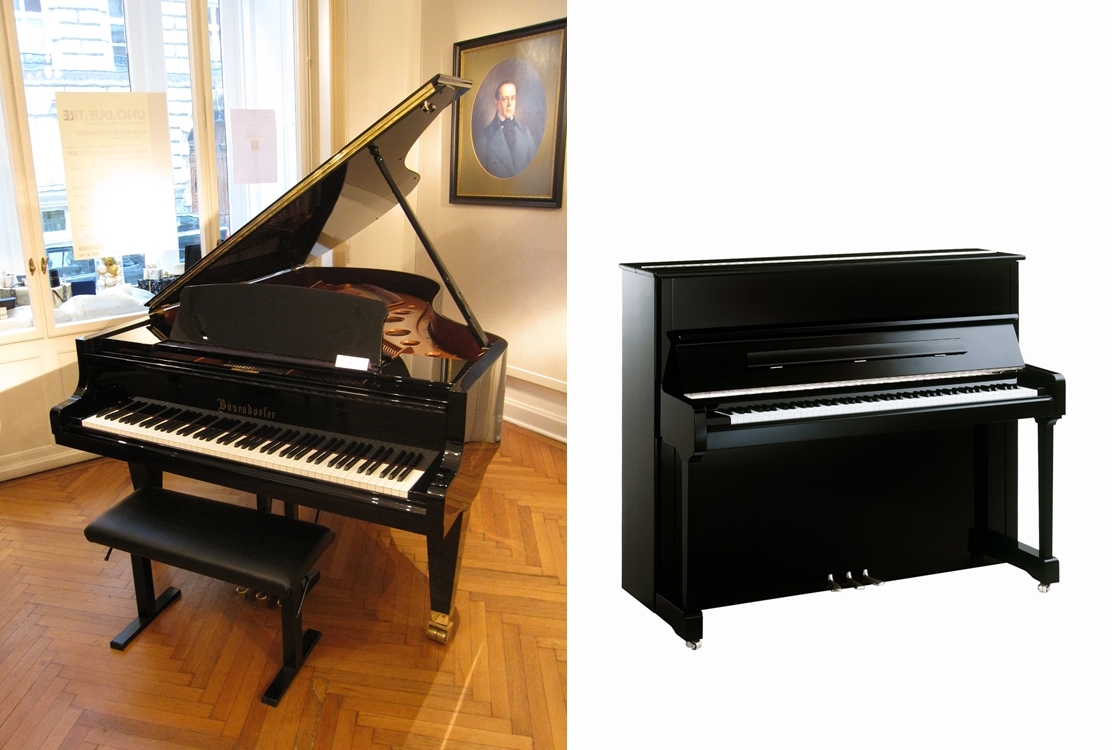7.2: The Piano in the Classical Era and the Piano Sonata
- Page ID
- 165650
The Piano.

(left): A grand piano; (right): and an upright piano. Uploaded to Creative Commons by Gryffindor and Megodenas. CC BY-SA 3.0.
The modern piano was invented around 1700 by Italian keyboard maker Bartolomeo Cristofori, originally called the "gravicembalo col piano e forte," which translates to "keyboard instrument that can play soft or loud." This was significant because the various predecessors to the piano were not capably of creating such a wide pallate of louds and softs. The piano underwent many evolutions through the next centuries, and although it was around during the Baroque period, its popularity gained steam in the early Classical Era (around 1730-1750). By the time the Classical Era was in full swing (1750-~1820), the piano was well-established.
Unlike the harpsichord family and the clavichord, the piano's strings are not plucked, but rather, they're struck with a felt-tipped hammer. The video presentation for this unit describes in further detail the intricate ways in which the piano creates sound.
Pianos in the Classical Era (1750-~1820) were quite different than modern-era pianos, and are often referred to as pianofortes. Though they were essentially created the same, there were significant differences in the specifics of its design. Because of this, pianofortes have a thinner and lighter sound. For music lovers who want a more "authentic" sound—that is, a sound that was more accurate to the time period in which it was written—listening to recordings of earlier piano works by Classical Era composers like Haydn and Mozart on the pianoforte is more satisfying. The video presentation for this unit demonstrates the difference in sound between a pianoforte and a modern era piano.
Composers in the Classical Era (1700-~1820) wrote many pieces for the solo piano. Some pieces were written as single movements -- we looked at a few single-movement pieces in Chapter 4.5 (a single-movement "Theme and Variation") and Chapter 4.6.2 (Fur Elise, which was a single-movement work in Rondo Form). However, many composers wrote piano sonatas, which were instrumental sonatas written for a single solo pianist. These are similar to the instrumental sonatas we briefly mentioned in Chapter 5.3, but instead of including another instrument, these pieces are written for a single performer.
The Piano Sonata: a 3-movement cycle

(above): a diagram depicting the 3 movements of an instrumental sonata
Composers of the Classical Era like Haydn, Mozart, and Beethoven all wrote many piano sonatas, exploring the capabilities of the solo pianist. Some of these pieces are incredibly difficult even by today's standards!
The piano sonata, similar to other instrumental sonatas in the Classical Era, typically contain 3 movements. The diagram below depicts the 3-movements of an instrumental sonata. Movements 1 and 3 are usually fast, and in the "tonic" or home key, while the 2nd movement is slow, and often in a different key. Similar to a 4-movement Classical Symphony or String Quartet, the first movement of an instrumental sonata is often in sonata form, while the last movement is typically in rondo form. The 2nd movement can be found in any movement --- as long as it's slow.
Although the first movement of the sonata is often fast, one of Beethoven's most famous piano sonatas, the "Moonlight" sonata subverts our expectations by using a slow movement for the 1st movement, a light-hearted dance for the second movement, and an incredibly expansive and technically challenging and demanding 3rd movement in sonata form! Watch this video of Daniel Barenboim perform this famous work; the first movement is incredibly peaceful, and is found in many "Classical Music to Relax To" playlists --- that third movement would never make that playlist, as it's violent, explosive, and exciting!
The First Movement of an Instrumental Sonata: Sonata Form
As mentioned above, the first movement of the instrumental sonata is in "sonata form," which you may recall from Chapter 4.6.3 when we looked at the first movement of Mozart's Symphony in G minor. For your benefit, the diagram from that chapter is reproduced here. As you can see, the music begins with an Exposition, and consists of 4 distinct sections: "theme 1," "transition," "theme 2," and "closing." After these sections, composers often repeat everything before moving into the "development" section, where the composer plays with small ideas that they introduced in the Exposition. After the development, the music moves into the "Recapitulation," which restates everything from the Exposition. The video presentation on this unit explores the first movement of Mozart's Piano Sonata in B flat Major, K. 333 in detail, which is what we call a "textbook example" of sonata form - that is, it follows this template to the T. Many other sonata movements deviate from this in some way or another.


